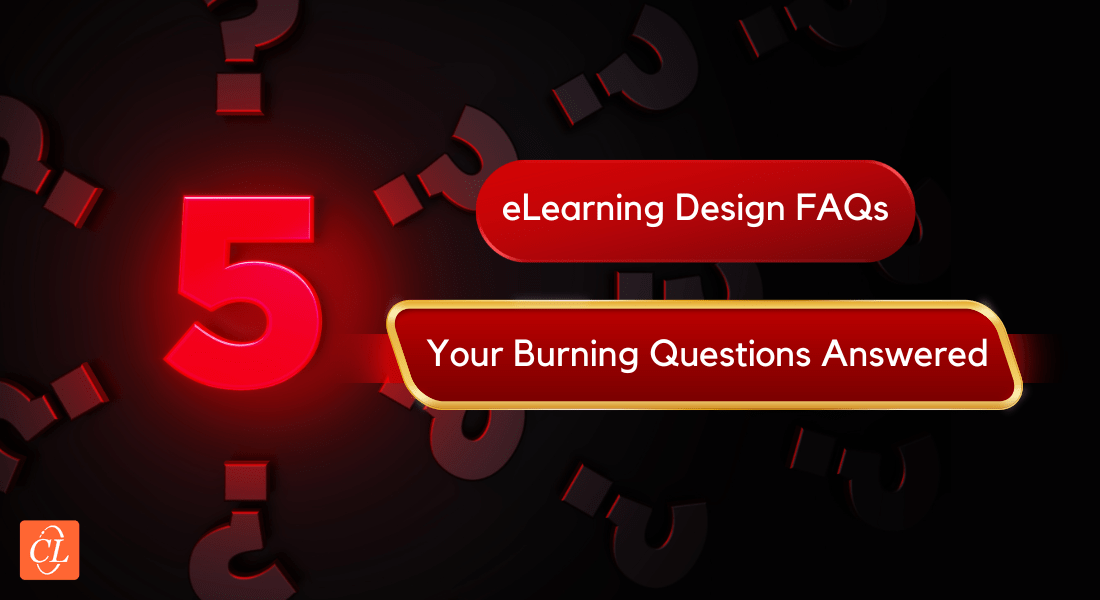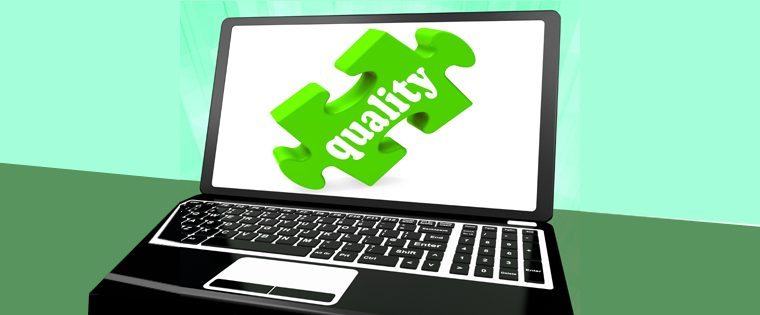Answering Burning Questions: 5 FAQs of eLearning Design & Development

ELearning for corporate training has been one of the top topics in the learning and development (L&D) circles for quite some time now! But what if I say that there are quite a few organizations still contemplating whether or not to adopt it? Yes, that’s right. There are many organizations across the globe that are yet to implement eLearning. One of the reasons behind it is that they are not very sure about eLearning design and development, and have several questions about it.
Did You Know: Organizations Are Holding Their eLearning Implementation Because of Some Questions?
Here Are The Top 5 FAQs on eLearning Design and Development
- What is eLearning Design and Development?
- The Process of Creating an eLearning Course
- How Do You Make an eLearning Course Engaging?
- What Technologies Are Used for eLearning Courses?
- What Benefits Does eLearning Offer?
(Continue reading for the answers)
Are you among such organizations? Do you have a lot of questions revolving eLearning design and development and are thud delaying the implementation? Then this blog is for you! The blog answers the top five questions revolving eLearning design and development.
So, without further ado, let’s dive in!
Top 5 FAQs on eLearning Design and Development
1. What is eLearning Design and Development?
eLearning design and development is the process of creating engaging, interactive, and effective online learning experiences. It involves the use of instructional design principles and technologies to create engaging content that can be delivered via the web or mobile devices.
When designing eLearning experiences, it is important to consider the different ways that learners prefer to receive information. Some learners prefer visual content, while others prefer auditory or textual content. It is also important to consider how much time learners have to devote to the learning experience.
eLearning designers work with subject matter experts and instructional designers to identify the best way to deliver content to learners. They also test and revise courses to ensure that they are effective.
2. The Process of Creating an eLearning Course
Creating an eLearning course can be a daunting task, but it doesn’t have to be! By following some simple steps and keeping a few eLearning design and development key considerations in mind, you can create an eLearning course that is engaging, interactive, and effective.
Here are the steps to creating an eLearning course:
- Define your objectives. What do you want your learners to achieve by taking your course? Write down your objectives and make sure they are SMART: specific, measurable, attainable, relevant, and time-bound.
- Choose your content. Select the topics and lessons you want to include in your course. Make sure your content is interesting and relevant to your learners.
- Develop your instructional design strategies. How will you present the content to your learners? Will you use audio narration? Video demonstrations? Written text? Graphics? A combination of these? Keep in mind how people learn best when deciding on your instructional strategies.
- Create your media assets. This step includes developing any graphics, videos, audio files, or other media that you will need for your course. If you’re not experienced with creating media assets, there are many online tools and resources available to help you get started.
- Build out your course structure. Organize and design your course using an authoring tool such as Articulate Storyline or Adobe Captivate. Again, if you’re not experienced with using these tools, there are many resources and tutorials available online to help you get started.
- Develop assessments. Create quizzes, surveys, and other eLearning assessment activities that will help you measure your learners’ progress and mastery of the material.
- Test and launch your course. When you’ve finished creating your course, it’s important to do a thorough test of all elements before launching it to your learners. Make sure everything is working as intended, that all content is accurate, and that the overall user experience is satisfactory.
By following these steps and keeping these key considerations in mind, you can create an effective eLearning course that meets the needs of your learners!
3. How Do You Make an eLearning Course Engaging?
When it comes to eLearning, engagement is key. After all, if your learners are not engaged, they are not going to learn as much as they could be. So, how do you make an eLearning course engaging? Here are a few tips to be followed during eLearning design and development:
- Make sure the content is relevant and interesting to your learners. If it isn’t, they will tune out quickly.
- Use a variety of multimedia elements to keep things interesting and engaging. visuals, audio, and video can all help with this.
- Keep your courses short and to the point. Learners will lose interest if you drag on for too long.
- Make sure there is a clear purpose for each course and each activity within the course. If learners don’t understand why they are doing something, they won’t be engaged.
- Allow learners to interact with the content in some way. This could be through discussion forums, quizzes, games, or other activities.
- Get feedback from your learners throughout the design process and make changes based on what they say. This will help ensure that the final product is engaging for the learners.
→ Download Now: Instructional Design Strategies to Design Engaging eLearning Courses
4. What Technologies Are Used for eLearning Courses?
There are many different technologies that can be used for eLearning courses, but the most common are Learning Management Systems (LMS) and authoring tools.
LMS platforms provide the foundation for hosting and delivering eLearning courses, and usually include features such as course administration, user tracking, and progress reporting.
Authoring tools are used to create the actual content for eLearning courses, and typically offer a wide range of features for creating interactive and engaging learning experiences.
Other technologies that are often used in eLearning courses include video conferencing software, webinars, and mobile apps.
5. What Benefits Does eLearning Offer?
eLearning can offer a number of benefits to both learners and instructors. For learners, eLearning can provide a more flexible and convenient learning experience, as well as access to a wider range of courses and materials. Additionally, eLearning can often be more cost-effective than traditional classroom-based instruction. For instructors, eLearning can offer the ability to reach a larger audience with less effort, as well as the opportunity to create more engaging and interactive instructional content.
Summing Up
I hope that this article has helped answer some of your burning questions about eLearning design and development. I have covered the benefits, misconceptions, popular tools, processes and more associated with creating an impactful online course. Now you can make an informed decision on which eLearning platform to use for your specific needs. With all this knowledge in hand, take confidence in designing engaging courses no matter what type of learner is involved.
Now that you have a fair knowledge on eLearning design and development, its time for you to start planning the implementation and this eBook can help you with 32 hands-on eHacks to help you…





